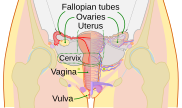The vagina is a fibromuscular elastic tubular tract (passage) which is a sex organ and mainly functions for the facilitation of sexual intercourse and childbirth. In mammals (especially primates), menstruation, which is the periodic discharge of blood and mucosal tissue from the inner lining of the uterus through the vagina, is another primary function of the vagina and usually signals fertility. The location and size of the vagina varies among species, and may vary in size within the same species. In humans, the vagina leads from the opening of the vulva to the uterus (womb), but the vaginal tract ends at the cervix.
The vagina plays a significant role in human female sexuality and sexual pleasure. During sexual arousal for humans and others animals, vaginal moisture increases by way of vaginal lubrication, to reduce friction and allow for smoother penetration of the vagina during sexual activity. In the absence or presence of sufficient vaginal lubrication, the texture of the vaginal walls can create friction for the penis during sexual intercourse and stimulate it toward ejaculation, enabling fertilization. In addition, a variety of sexually transmitted infections (STIs/STDs) and other disorders can affect the vagina. Because of the risk of STIs/STDs, health authorities, such as the World Health Organization (WHO), or other health outlets, recommend safe sex practices. (Full article...)
